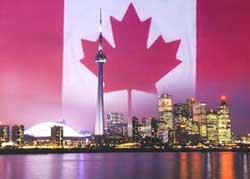| Canadian Immigration and Population Surge
The Canada eZine - Demographics
33 Million CanadiansBy Monique Bellamont - Dec. 19th 2007. Despite a low birth rate there is now more than 33 million people living in Canada, according to figures released today from Statistics Canada and it includes some surprising figures. Saskatchewan has replaced Alberta as the fastest-growing province, with more than one million people for the first time since 2001. The numbers are based on population counts from the 2001 Census and 2006 Census. That is a lot of Saskatechewan Roughriders fans. As of Oct. 1, 2007, Canada's population was estimated at 33,091,200. It is the strongest growth rate in six years. Provincially, Saskatchewan, British Columbia, Ontario and Alberta had population growth rates higher than the rest of the country with Saskatchewan's population reaching a record high of 1,003,300. Immigration also remained strong with Canada receiving an estimated 71,600 newcomers, an increase not seen in more than 30 years. Alberta, which has typically led the provinces in population growth due to their strong economy, has started to lose more people to other regions with provinces such as Newfoundland & Labrador and Saskatchewan benefiting the most. The population of all four Atlantic provinces rose, but at a slower pace than the rest of Canada. Prince Edward Island was the fastest-growing province in the Atlantic region. It also received more immigrants than ever before. Newfoundland and Labrador's population was estimated at 507,500, up by 1,200, the highest increase since 1992. Usually Newfoundland and Labrador has a population drain due to a shortage of available jobs and people moving to other provinces to find work. New Brunswick also posted an increase, while Nova Scotia had the slowest population growth among the provinces of just below 1,000 people. Manitoba, British Columbia and Ontario are the other provinces posting an immigration rate higher than the national level. Ontario's population increased to an estimated 12,850,600, a faster growth rate than the rest of country due mainly to interprovincial migration.
However, Ontario's attraction for immigrants is declining. The population of Quebec, the second most populous province, increased but at a slower rate than the national average. The number of births in Quebec is still on the rise, and its rate of natural increase is second only to Alberta which leads the country with the highest birth rate. British Columbia's population hit an estimated 4,402,900, the second fastest growth-rate among the provinces, due mainly to an increase in interprovincial migration. International migration accounted for nearly 60 per cent of B.C.'s growth. Manitoba saw a demographic increase slightly below the national rate although it is the province's strongest increase since 1983 due to strong influx of immigrants. The only territory to post a faster demographic growth rate than the rest of the country was the Yukon, where the population reached 31,100. Statistics Canada says the Northwest Territories was the only jurisdiction to record a decline in population, largely because of interprovincial migration while Nunavut posted one of the smallest population increases in its brief history. Without its strong birth rate, Nunavut's population would have declined.
Separatists Upset about ImmigrationCanada is becoming a nation of immigrants again and Quebec Separatists don't like it one bit. Canada's foreign-born population grew four times as fast as that of the Canadian-born population during the first half of this decade to reach a 75-year high of nearly one in five people living here, according to the latest analyses of data from last year's census. The 13.6 per cent surge in Canada's foreign-born population between the 2001 and 2006 censuses, compared with the 3.3 per cent growth in the Canadian-born population, was mostly due to the arrival of 1.11 million new immigrants, Statistics Canada noted in its analyses on "Immigration, citizenship, language, mobility and migration." The proportion of foreign-born, which was at 22.2 per cent in 1931, fell during the Depression and the Second World War to a low of 14.7 per cent in 1951, and has been rising since. The relatively rapid growth in Canada's immigrant population is seen as a potential offset to looming labour shortages that will follow the start of the retirement of the baby boom generation, especially in historically high population provinces such as Ontario, Quebec and British Columbia. Supporting that view is the census finding that 57.3 per cent of immigrants to Canada over the past half decade were in the prime working age group of 25 to 54 years, compared with only 42.3 per cent of the Canadian-born population. And for the first time, in a land with more than 200 mother tongues, allophones - people whose mother tongue is neither English nor French - accounted for a full fifth of the population. The increase in the proportion of allophones is mainly due to the immigrants who arrived during the latest census period, as four out of five of them had a mother tongue - the first language learned and still understood - that was neither French nor English.
13.8% of Quebec's population is now foreign-born and this percentage keeps growing despite a high birth rate amongst Quebec's primarily Catholic population. These newcomers, nearly 60 per cent of whom were born in Asia, including the Middle East, made up almost 18 per cent of the foreign-born population in 2006, or 3.6 per cent of Canada's total population of 31.2 million. The proportion of new immigrants who were born in Asia was unchanged from the previous census but was up from only 12.1 per cent 2-1/2 decades earlier, Statistics Canada noted. Immigrants also tend to be better educated, especially the younger immigrants, added Jean-Pierre Corbeil, with Statistics Canada's language and demographics section. "Everyone sees immigration as one way to counter this aging factor," he noted in an interview. "It's not the only way, but it's certainly one important way." The continuing flow of immigrants here has also left Canada with a much higher proportion of foreign-born than the United States, 19.8 per cent compared to 12.5 per cent. In fact, only Australia has a higher proportion of foreign-born than Canada. And for the first time the foreign-born population from Asia and the Middle East in 2006 exceeded that from Europe. Newcomers from Europe, who used to make up the majority of new immigrants to Canada, accounted for just 16.1 per cent of immigrants over the half decade, down from more than 60 per cent as recently as 1971. During the latest census period, just over 10 per cent of new immigrants were from Central and South America and the Caribbean, and another 10.6 per cent were born in Africa. Regardless of where immigrants were from separate Statistics Canada surveys found that Canada was the only choice for 98 per cent of them. Those surveys found the largest proportion said they came to improve the future for their family, and when asked four years later why they planned to stay also cited the quality of life here and the positive future prospects for their family. Meanwhile, Canada's three largest metropolitan areas became home to more than two-thirds of new immigrants, between two to three times the 27.1 per cent of Canada's total population who call Toronto, Vancouver or Montreal home. Toronto accounts for 37.5 per cent of the total immigrant population, the highest of the three by far, and 40.4 per cent of recent immigrants. While most of the recent immigrants live in the core of the metropolitan areas, more are also moving out to the suburbs. A slightly higher proportion than during the previous census period -16.6 per cent compared with 14.3 per cent - also chose to settle in the smaller metropolitan areas of Calgary, Ottawa-Gatineau, Edmonton, Winnipeg, Hamilton and London. Nearly 87 per cent of the foreign-born population live in three provinces: Ontario, with 54.9 per cent, British Columbia with 18.1 per cent, and Quebec with 13.8 per cent. Those three provinces also received nearly 86 per cent of newcomers since 2001. In contrast, foreign-born people account for less than four per cent of the population of Atlantic Canada. Meanwhile, more than 85 per cent of the foreign-born who were entitled to become Canadian citizens had done so. While only 2.8 per cent of all Canadian citizens, or 863,100, also had at least one other citizenship, four-fifths of those were foreign born, with the largest single proportion being the 14.7 per cent who held British citizenship, followed by 6.6 per cent Polish, and 5.4 American. The news that Montreal and Quebec are major destinations for immigrants won't be making Separatists happy. Separatists are notoriously anti-immigration and dislike English-speakers and Allophones settling in Quebec and disrupting the "preservation of Quebec culture and language".
|
|
|

Immigrants heading to Canada's largest citiesThe 2006 census counted 6.2 million allophones in Canada - people whose mother tongue is neither French nor English - and a large majority of them live in just six cities across the country. In its 2006 census report on language published Tuesday, Statistics Canada reported that 87 per cent of allophones live in census metropolitan areas (CMAs) and most of them, 72 per cent, reside in Toronto, Vancouver, Montreal, Calgary, Edmonton and Ottawa-Gatineau. The CMAs of Hamilton, Winnipeg and Kitchener together account for another six per cent of allophones in Canada, the report indicated. In Toronto, more than 44 per cent of residents have a mother tongue other than French or English, the largest proportion of allophones among the CMAs. Chinese languages were the most dominant non-official languages, followed by Italian, then Punjabi. Forty-one per cent of Vancouver residents are allophones according to the 2006 census, compared to 38 per cent in 2001. The largest non-official language groups are Chinese, Punjabi, Tagalog and Korean. A different set of languages was observed in: Montreal for that city's allophones. Italian topped the list, followed by Arabic and then Spanish. The Montreal CMA has proportionally far fewer allophones - 22 per cent - than Toronto and Vancouver. Roughly one resident in five in Calgary was allophone in 2006, up slightly from 2001 and at 56,000 people, Chinese is the largest allophone group. Chinese was also the dominant language group among allophones in Alberta's other major city, Edmonton. Ranking second and third were German and Ukrainian but they are declining and as in other CMAs, Punjabi, Tagalog, Spanish and Arabic are on the rise in Edmonton. In Ottawa-Gatineau, Arabic is the leading non-official mother tongue with 31,000 people, followed by Chinese and Spanish. Although allophones tend to concentrate in Canada's larger cities, the Statistics Canada report noted that a growing number of them are settling in the suburbs, especially in Toronto and Vancouver. In Markham for example, outside of Toronto, 57 per cent of residents have a mother tongue other than French or English. Similarly, outside of Vancouver in Burnaby, 55.5 per cent of residents are allophones.
| ||



